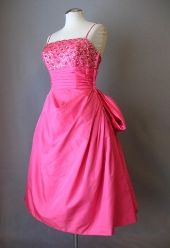I've been reading "The Chaperone" by Laura Moriarty and enjoying it immensely. I can never read a book or watch a film without noticing anything having to do with fashion. One of the things Moriarty gets right in her book is how the main character Cora feels when wearing the corset that fashion dictated for her in 1922. When Cora drops her book on the floor during a train ride, she cannot bend to pick it up herself. When she is hungry, she cannot eat a lot of food at one time due to the constraints on her midsection. And when she removes her corset, the bones leave red marks and indentations on her skin.
This morning, I was flipping through an exhibition catalog from The Museum at the Fashion Institute of Technology in New York. This is a wonderful jewel of a museum that I always make a point to go and visit when I am in the city. It's free and a short walk from Penn Station. As I was enjoying the images in the catalog, I found the two shown here which gives a wonderful example of the underpinnings a woman had to wear to look fashionable in 1882. That's a bit earlier than Cora's corset, but the idea is the same. Enjoy!
Afternoon velvet dress, c. 1882, probably American. I love the sumptuous brocade and each of those 19 buttons has a hand stitched buttonhole.
What would the owner of that afternoon dress have worn underneath it? First, the cotton combination and pettipants (not shown). This combination has an unusual button-on short petticoat. Then a fully boned corset like this one made of wool and silk c. 1880. Over that, a bustle would have been tied on. This one is made of wire. And over all of it would be multiple full length petticoats, also not shown here. They would be made of cotton, silk or wool depending on the wealth of the owner and the time of year.
Images from The Museum at the Fashion Institute of Technology
This morning, I was flipping through an exhibition catalog from The Museum at the Fashion Institute of Technology in New York. This is a wonderful jewel of a museum that I always make a point to go and visit when I am in the city. It's free and a short walk from Penn Station. As I was enjoying the images in the catalog, I found the two shown here which gives a wonderful example of the underpinnings a woman had to wear to look fashionable in 1882. That's a bit earlier than Cora's corset, but the idea is the same. Enjoy!
Afternoon velvet dress, c. 1882, probably American. I love the sumptuous brocade and each of those 19 buttons has a hand stitched buttonhole.
What would the owner of that afternoon dress have worn underneath it? First, the cotton combination and pettipants (not shown). This combination has an unusual button-on short petticoat. Then a fully boned corset like this one made of wool and silk c. 1880. Over that, a bustle would have been tied on. This one is made of wire. And over all of it would be multiple full length petticoats, also not shown here. They would be made of cotton, silk or wool depending on the wealth of the owner and the time of year.
Images from The Museum at the Fashion Institute of Technology

















